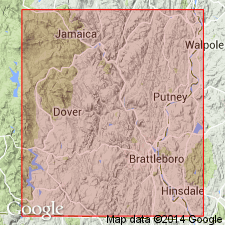
- Usage in publication:
-
- Green Mountain gneiss
- Modifications:
-
- Original reference
- Dominant lithology:
-
- Gneiss
- AAPG geologic province:
-
- New England province
Summary:
[Green Mountain gneiss is listed as next to oldest formation in Vermont, lying below talcose slate and above "gneiss proper."]
Source: US geologic names lexicon (USGS Bull. 896, p. 871).
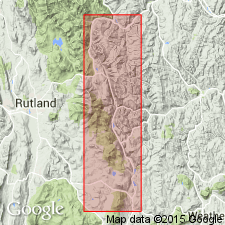
- Usage in publication:
-
- Green Mountain gneiss
- Modifications:
-
- Overview
- AAPG geologic province:
-
- New England province
Summary:
Mentioned "the gneissoid mica slate or Green Mountain gneiss."
Source: US geologic names lexicon (USGS Bull. 896, p. 871).
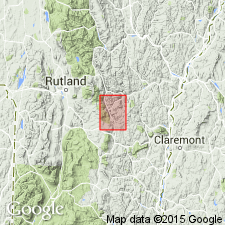
- Usage in publication:
-
- Green Mountain gneiss
- Modifications:
-
- Mapped
- AAPG geologic province:
-
- New England province
Summary:
Mapped Green Mountain gneiss.
Source: US geologic names lexicon (USGS Bull. 896, p. 871).
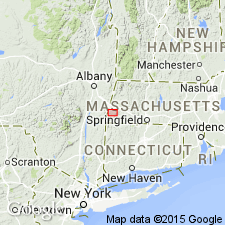
- Usage in publication:
-
- Green Mountain series
- Modifications:
-
- Age modified
- AAPG geologic province:
-
- New England province
Summary:
Pg. 370. The so-called "Green Mountain series" has been pronounced on lithological evidence to be pre-Silurian and Huronian.
Source: US geologic names lexicon (USGS Bull. 896, p. 871).
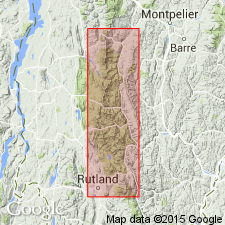
- Usage in publication:
-
- Green Mountain gneiss
- Modifications:
-
- Overview
- AAPG geologic province:
-
- New England province
Summary:
A. Wing, v. 13, p. 334-347, 404-419. Showed oldest formation of western Vermont as "gneiss, often called Green Mountain gneiss."
Source: US geologic names lexicon (USGS Bull. 896, p. 871).

- Usage in publication:
-
- Green Mountain gneiss
- Modifications:
-
- Age modified
- AAPG geologic province:
-
- New England province
Summary:
Pg. 464. The Green Mountain gneiss underlies the green schists in Green Mountains. The Green Mountains are not Huronian but are flanked by it on both sides in northern half of Vermont. They belong to Montalban series and are nearer the Laurentian than the Huronian. The use by Dr. Hunt in 1871 of Green Mountains gneiss for the Huronian is improper and inappropriate.
Source: US geologic names lexicon (USGS Bull. 896, p. 871).
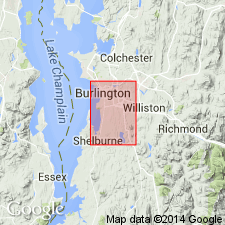
- Usage in publication:
-
- Green Mountain series
- Modifications:
-
- Areal extent
- Age modified
- AAPG geologic province:
-
- New England province
Summary:
Pg. 249-256. Green Mountain series (of gneisses, schists, etc.) covers eastern part of Burlington quadrangle, Vermont. I believe they are made of Cambrian and Ordovician strata.
Source: US geologic names lexicon (USGS Bull. 896, p. 871).
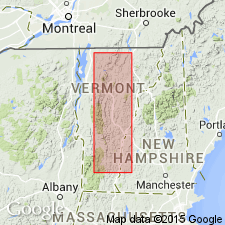
- Usage in publication:
-
- Green Mountain
- Modifications:
-
- Age modified
- AAPG geologic province:
-
- New England province
Summary:
Pg. 21-56. The foundation of Green Mountains is of Algonkian age. Archean may be represented in axis of Green Mountains.
Source: US geologic names lexicon (USGS Bull. 896, p. 871).
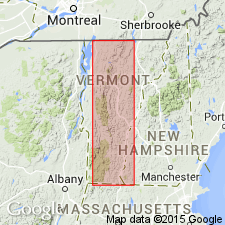
- Usage in publication:
-
- Green Mountain gneiss
- Modifications:
-
- Age modified
- AAPG geologic province:
-
- New England province
Summary:
Pg. 305-313. Assigned Green Mountain gneiss to Algonkian; also in 11th Rpt. Vermont State Geol.
Source: US geologic names lexicon (USGS Bull. 896, p. 871).
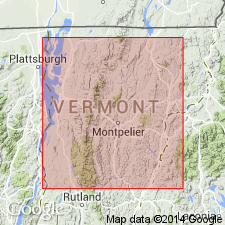
- Usage in publication:
-
- Green Mountain gneiss
- Modifications:
-
- Age Modified
- AAPG geologic province:
-
- New England province
Summary:
Assigned Green Mountain gneiss to Lower Cambrian, Upper Cambrian, and Beekmantown (Lower Ordovician).
Source: US geologic names lexicon (USGS Bull. 896, p. 871).

- Usage in publication:
-
- Green Mountain gneiss
- Modifications:
-
- Overview
- AAPG geologic province:
-
- New England province
Summary:
On 1932 geologic map of the U.S. the rocks of Green Mountains, Vermont, are mapped as Archean gneiss and Algonkian(?) sedimentary schists.
Source: US geologic names lexicon (USGS Bull. 896, p. 871).
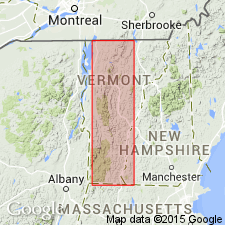
- Usage in publication:
-
- Green Mountain series
- Modifications:
-
- Overview
- AAPG geologic province:
-
- New England province
Summary:
Pg. 36-37. Age of the Green Mountain series is Precambrian.
Source: US geologic names lexicon (USGS Bull. 1200, p. 1603-1604).
For more information, please contact Nancy Stamm, Geologic Names Committee Secretary.
Asterisk (*) indicates published by U.S. Geological Survey authors.
"No current usage" (†) implies that a name has been abandoned or has fallen into disuse. Former usage and, if known, replacement name given in parentheses ( ).
Slash (/) indicates name conflicts with nomenclatural guidelines (CSN, 1933; ACSN, 1961, 1970; NACSN, 1983, 2005, 2021). May be explained within brackets ([ ]).

